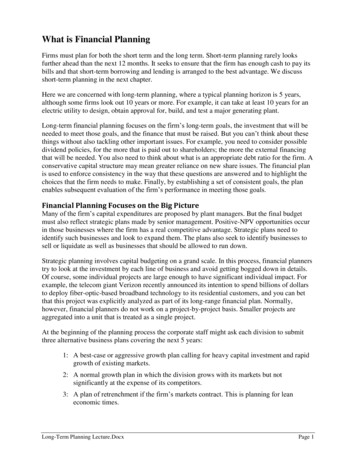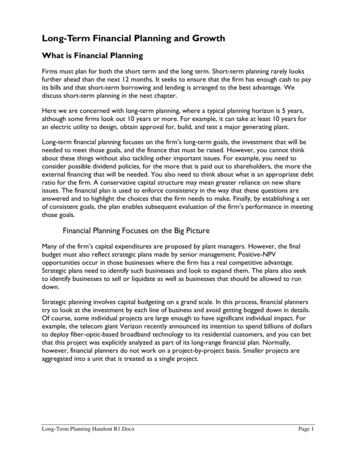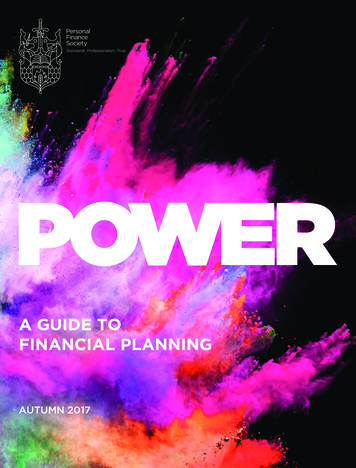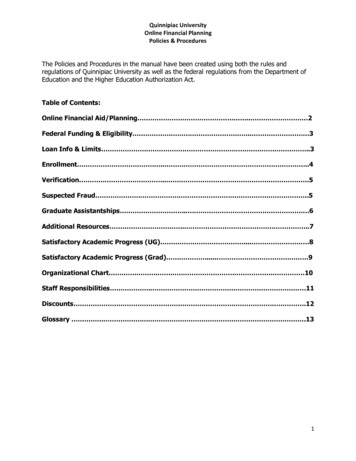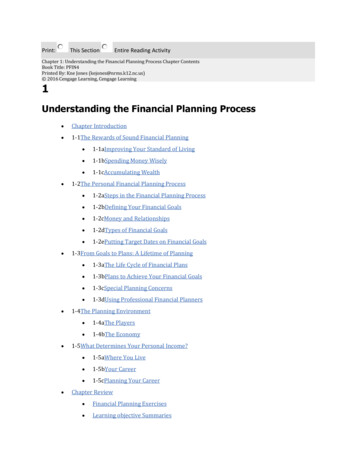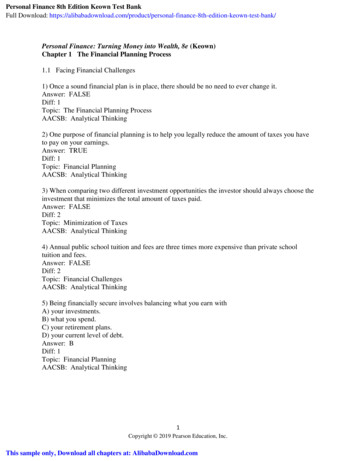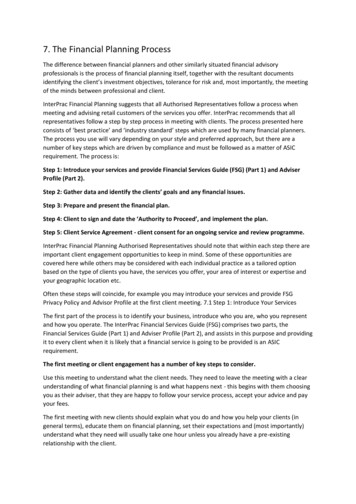
Transcription
7. The Financial Planning ProcessThe difference between financial planners and other similarly situated financial advisoryprofessionals is the process of financial planning itself, together with the resultant documentsidentifying the client’s investment objectives, tolerance for risk and, most importantly, the meetingof the minds between professional and client.InterPrac Financial Planning suggests that all Authorised Representatives follow a process whenmeeting and advising retail customers of the services you offer. InterPrac recommends that allrepresentatives follow a step by step process in meeting with clients. The process presented hereconsists of ‘best practice’ and ‘industry standard’ steps which are used by many financial planners.The process you use will vary depending on your style and preferred approach, but there are anumber of key steps which are driven by compliance and must be followed as a matter of ASICrequirement. The process is:Step 1: Introduce your services and provide Financial Services Guide (FSG) (Part 1) and AdviserProfile (Part 2).Step 2: Gather data and identify the clients’ goals and any financial issues.Step 3: Prepare and present the financial plan.Step 4: Client to sign and date the ‘Authority to Proceed’, and implement the plan.Step 5: Client Service Agreement - client consent for an ongoing service and review programme.InterPrac Financial Planning Authorised Representatives should note that within each step there areimportant client engagement opportunities to keep in mind. Some of these opportunities arecovered here while others may be considered with each individual practice as a tailored optionbased on the type of clients you have, the services you offer, your area of interest or expertise andyour geographic location etc.Often these steps will coincide, for example you may introduce your services and provide FSGPrivacy Policy and Advisor Profile at the first client meeting. 7.1 Step 1: Introduce Your ServicesThe first part of the process is to identify your business, introduce who you are, who you representand how you operate. The InterPrac Financial Services Guide (FSG) comprises two parts, theFinancial Services Guide (Part 1) and Adviser Profile (Part 2), and assists in this purpose and providingit to every client when it is likely that a financial service is going to be provided is an ASICrequirement.The first meeting or client engagement has a number of key steps to consider.Use this meeting to understand what the client needs. They need to leave the meeting with a clearunderstanding of what financial planning is and what happens next - this begins with them choosingyou as their adviser, that they are happy to follow your service process, accept your advice and payyour fees.The first meeting with new clients should explain what you do and how you help your clients (ingeneral terms), educate them on financial planning, set their expectations and (most importantly)understand what they need will usually take one hour unless you already have a pre-existingrelationship with the client.
It is also important to be mindful of when and how you see the client. You should ensure that you dosee the client in a situation where you have their full attention. If you are going to see a client out ofyour office, schedule the meeting in an appropriate venue for full and frank discussion by the client,where they will not feel rushed.InterPrac Financial Planning National Practice Manager is available to assist you with any questions7.2 Step 2: Gather Data, Identify Client Goals.Once you have provided the FSG and discussed your services, you need to understand and agreewith the client what the initial scope of the engagement will be and this may be general at this stagesuch as “review superannuation and prepare for retirement”, you then proceed to collect the datato gain an understanding of the client’s goals and financial situation.All advisers must use a document for the process for obtaining all relevant information from theclient; this is called the Fact Find. Some circumstances may allow you to progress to the Fact Findstep as part of the first meeting.7.2.1 Fact FindIt is the financial planner who is responsible for the giving of advice which will, or should, improvethe financial position of the client. In this context, the adviser is to know the client, know theproduct, how it works and what it provides, and then match the product to the needs of the client.In addition to being a licensee requirement, the structured process of using a ‘Fact Find’ in theprocess of gathering client information ensures that you do not overlook asking relevant questions.Copies of the InterPrac Fact Find are in your adviser kit, and suggested guidelines for ‘Getting toknow your client’ are in Appendix 7.2.1A in this manual. Collection of factual data from a prospectiveclient is one thing, but you also need to establish: Their level of literacy and ability to articulatetheir needs; What degree of ‘financial’ literacy that the client has; Ability to receive and acceptyour advice; and Ability to pay for your service. In all cases your file must note that you made anassessment of: The person’s ability to articulate their needs both long and short term; The level ofunderstanding of investment markets and investment terms the person has; and The person’semotional condition and concerns with investing or accepting advice. It is important to demonstratethat the client has understood and provided informed consent to continue with the advice process.As an Authorised Representative of InterPrac Financial Planning you mustcomplete a Fact Find.The Corporations Act requires that you gather relevant client information, and completing the FactFind is critical in this process. To give advice you must know the client and we do not accept this ispossible if you do not know all of the information the Fact Find seeks to determine.If the client refuses to complete a Fact Find, a warning must be provided on the risks associated withproviding inaccurate or incomplete information, and that the client must ensure that any advice isappropriate for them. If you do not complete a Fact Find because the client does not want to providethis information, the only advice you are able to give is limited scope advice and your Statement ofAdvice (SoA) must disclose this.Completing a detailed Fact Find can take two hours or more unless you already have a pre-existingrelationship with the client or have asked them to complete some of the Fact Find.
7.2.2 Risk ProfilePart of completing the Fact Find is an additional supporting document for assessing the client’s ‘riskprofile’, and tolerance for risk. It is important that you accurately understand and interpret yourclients’ attitudes to and capacity for risk. A financial planner needs to understand: A client’s riskattitude (a psychological attribute). A client’s risk capacity (a financial attribute). Determining aclient’s risk profile is the process of understanding and qualifying a client’s emotional (rather thantheir rational) feelings about possible scenarios and how they are prepared to risk for the chance toachieve specific outcomes.In the InterPrac Financial Planning Fact Find there are three ways to determine the risk profile: 1. Byasking qualitative questions to understand the client’s perception and attitude to risk; 2. By a pointsbased questionnaire; or 3. By going through the risk profiles and explaining and matching anappropriate one with the clients understanding of what their risk profile is.This process provides you with a basis for discussion with the client, so that the results can befurther discussed and confirmed, and file notes made. The risk profiling process needs to becompleted for each individual as the partners may have different tolerances for risk and this willneed to be addressed in any strategy considered, Statement of Advice (SoA) developed and productsolution selected.The InterPrac Financial Planning Risk Profile requires the client sign off on a choice of risk profileswhich they have clearly identified. However, advisers may use a number of additional risk profilingtools which are available (Finmetrica, XPLAN, Proquest, AdviserLogic, Coin and Midwinter all providesoftware tools), each with a different basis for assessing the risk. Risk profiling will help you ‘knowyour client’ and understand a client’s tolerance for risk, and this in turn will assist you in providingclient appropriate advice. Whatever tool is chosen, it will provide evidence that the risk profile wasappropriate, given the information that a client has conveyed.31 Compliance Manual v3. 4The Fact Find document is where you should record file notes about any variations between theclient’s risk profile assessment and your own intuitive diagnosis about a client’s tolerance for risk.Following the completion of the Fact Find and Risk Profile you are in a position to agree with theclient on the Scope of the Engagement which may be expanded from the original client engagementand details the areas of advice that you believe the client should receive advice upon to reach theirFinancial Goals and Objectives. This will likely involve the collection of further client information orproduct and strategy investigation which is the key requirement of Best Interest.7.2.3 File NotesThey might sound unglamorous, but don’t underestimate the power of file notes. They are a riskmanagement tool, a bridge to a better client relationship, and could help increase the value of yourbusiness. Contact the National Compliance Manager if you have any questions.Regulators have been clear that providing a record of the reasons for advice is imperative. Whileadvisers work with templates, such as Statements of Advice, and Fact Finds, one component ofrecord keeping that is less structured is the file note. With regulators insisting you make adequateenquiries concerning clients’ personal circumstances and demonstrate regard for the informationobtained through such enquiries, taking file notes becomes an important part of the smooth runningof your business, and potentially the key to its continued existence.
Effective management of client files makes managing your business much more efficient. There are 2main reasons why you need to have good files: 1. Internal - It is easier to delegate work or manageclient files if the information is accessible, complete and correctly filed. 2. External - It is easier tomanage the client relationship and service if you maintain the client information.Good file notes are part of this process and can be kept chronologically. They are also a form ofmanaging risk. The most valuable file notes are: Clear - the notes can be read and understood bysomeone other than you. Concise - include relevant material only. Comprehensive - all importantpoints are covered. The file notes should record not just the client’s personal circumstances, butinclude the consideration and investigation which you considered when formulating a strategy andthe advice given. Please ensure you file note all meetings and conversations with your clients.The file notes in regard to the advice provided continue through the process and include theimplementation phase of the advice. Where electronic (paperless) files are utilised and handwrittennotes are prepared at meetings off-site then in addition to summarising those notes electronicallythe actual handwritten note should be uploaded to the file as a contemporaneous recording.7.3 Step 3: Prepare and Present the Plan (SoA)Giving a client personal advice triggers the need to provide a Statement of Advice (SoA).SoAs must be provided for all retail clients. Non-retail clients do not require SoAs. However, youMUST have signed by an Accountant, a declaration confirming the investors’ status as a WholesaleClient or Professional Investor. Regulations commencing 1st July 2015 changed some aspects of howadvisers can classify clients as non-retail clients. See Appendix 1.1A for definitions, and Appendix 7.4Wholesale Client / Professional Investor Declaration Form.For all retail clients it is vital that the SoA is consistent with the statements made in the FSG. The firstcomponent of preparing and presenting the advice is to ensure that the information you have reliedupon to give the advice is accurate. This should be clearly identified in the Statement of Advice andis important in you complying with the ‘know your client rule’.However, before addressing the SoA, you need to ascertain the right strategy or strategies for theclient based on the Fact Find process and what product solutions can assist you to deliver thedesired outcome. Additional resources to assist in ascertaining the right strategies, are availablethrough support services like technical help desks of product provides, software you may choose touse, or from InterPrac Financial Planning directly. Remember, if you are not sure, please ask.When using a paraplanner, it is important you provide a copy of the Fact Find and the strategy /recommendation you are making. This is the first step to a compliant SoA. Having some idea of theproduct solutions which may be relevant for this client will also assist to get the SoA completedmore quickly and in line with your requirements.It is your responsibility to make sure the plan is exactly what you want and is clear in therecommendations. Remember, you are giving the advice, not the paraplanner, this applies whetherthe paraplanner is in-house or outsourced.The SoA should always show your calculations and the thinking behind how you decided on astrategy in your notes, (as you would do when instructing a paraplanner). The key to goodpreparation in this regard is that if someone at a later date picks up the client file, it is clear how youcame to provide the advice in the SoA.
If the client has specifically requested that the advice only covers specific areas of advice, ensurethat the SoA clearly records this.InterPrac Financial Planning provides you with a SoA template and Strategy and Appendix notes toaccompany the SoA, to use in a Word format, which can be accessed through the InterPrac FinancialPlanning Adviser Intranet site. We also have AdviserLogic, XPLAN and Midwinter software templateversions for advisers using software to help create the SoA. InterPrac will consider any requests toalter our existing templates but require that unless express consent has been provided, ourtemplates are used in their current form.A Statement of Advice (SoA) includes:1. Front Cover with details of InterPrac AFSL, Adviser Representative Number and date2. Scope of advice.3. Detail of the clients Financial Goals and Objectives.4. Relevant Client Details and Risk Profile.5. Recommended Strategy or Strategies to meet the clients’ objectives.6. All product and advice recommendations.7. Outcomes of the advice including ongoing service recommendation and offering.8. Why the product/s are appropriate, specifically for that client and where a replacementproduct has been recommended, a comparison between the existing and recommendedproducts, why the existing product is no longer suitable, and the tangible benefits ofreplacing the product.9. Risks of the advice.10. The Appendices to the SoA should contain information about products, including theresearch you undertook and Product Disclosure Statement (or product brochure), togetherwith further explanations about risk and the client data on which the advice is based.11. Fees / charges / commission from the recommendations.12. Disclaimer.13. The Authority to Proceed (see Step 4 in Section 7.4).14. Any projections or statistical information.15. What to do next.The SoA may also contain a cover letter, particularly relevant if the SoA is being posted or emailed inplace of, or before or after the meeting.Your SoA must demonstrate a clear understanding of your client, the recommended strategy and theproducts used to achieve the client’s goals / objectives which meet the ‘reasonable basis’ guidelines.7.3.1 ‘Advice must be in the client’s best interests’The Reasonable Basis requirements s945A of the Corporations Act have been replaced with a BestInterest test, which expands on the requirements of the advice to ‘Know the Client and the Product’and places a particular focus on the client being in a better position by accepting the advice thanthey would otherwise have been.It is important that your documentation and explanation to the client identifies how the advice willboth meet the clients’ objectives and be in the clients’ best interest.The SoA presentation meeting may take one to two hours (or more subject to plan scope, strategycomplexity and client questions).
7.3.2 Statement of Advice (SoA) Review ChecklistThe SoA Review Checklist has been created for your use to self-check each SoA you produce for yourclient to ensure it meets all key compliance, strategic and client best interest duties as directed byInterPrac Financial Planning and ASIC plus Corporation Law regulations. It is a requirement for alladvisers to use this checklist tool for all Statement of Advice produced to meet best practicerequirements.7.4 Step 4: Execute ‘Authority to Proceed’ and Implement the PlanAt the back of your SoA there is an ‘Authority to Proceed’.This page indicates that the client is ready to proceed with the adviser’s recommendations.It is important that this page is signed and dated by the client for both parties’ records, and a copy ofthis signed page is kept in the client file.Once the client has signed the Authority to Proceed, you can implement your recommendations.Implementation of the recommendations as outlined in the SoA is another important process andcan be done by administration or support staff. Implementation involves completing (in conjunctionwith the client) all necessary application and authority forms, lodging documents and engaging incommunication with product provider administration or business support staff.The time taken to complete the implementation process will vary from client to client and strategyto strategy. It is important to keep the client up to date with the progress and inform them of anyunavoidable delays.7.5 Step 5: Client Service AgreementOnce the implementation of the SoA has occurred, an additional, short meeting with the client canbe held to confirm what has occurred. You can use this time to present them with your ongoingclient service offering and if they wish to participate, to complete the agreement for this service on afee for service basis. There are many options and a simple Client Service Package example isprovided in Appendix 7.5A of this manual.A financial plan is based on your clients’ needs and circumstances at the time of the advice. If a planis not reviewed regularly then the advice may become irrelevant to your clients changing situation.Periodic review helps to ensure that you are aware of any changes in your clients’ personalcircumstances, and your clients are aware of the impact economic and/or legislative changes mayhave on achieving their goals. The review process helps to keep clients on target with their goals andgrows stronger mutually beneficial working relationships. While providing clients with an ongoingservice program or service package is not a compulsory activity, it is highly recommended.To assist you with the development and implementation of an ongoing service program, theInterPrac Financial Planning National Practice Manager is available to assist with any questions youmay have.
client; this is called the Fact Find. Some circumstances may allow you to progress to the Fact Find step as part of the first meeting. 7.2.1 Fact Find It is the financial planner who is responsible for the giving of advice which will, or should, improve the financial position of the client. In this context, the adviser is to know the client .





